10.1 ZENworks Middle Tier Server Installation Procedure
When you have met the hardware and software requirements and prerequisites for installation (see Prerequisites for Installing the ZENworks Middle Tier Server), use the following steps to get the ZENworks® Middle Tier Server up and running on a NetWare® or Windows server.
-
Select a Windows 2000/XP workstation (or a Windows 2000/2003 server) to run the Middle Tier Server installation program. The workstation or server must meet the requirements for an installing workstation. For details, see Prerequisites for the Workstation Running the Installation.
-
At a Windows workstation, insert the Novell ZENworks 7 Desktop Management CD.
If you run the installation from a directory location where you have copied the ZENworks Desktop Management ISO files, make sure that all of these files are copied to the same location from which you are running winsetup.exe.
IMPORTANT:If you remove the Novell ZENworks 7 Desktop Management CD from the CD drive during the installation, or if you lose your connection to the server you are installing to, the installation program stops and does not proceed. To terminate the installation process, open the Windows Task Manager, click , select javaw.exe, then click .
The winsetup.exe program autoruns. If it does not autorun, launch the program from the root of the CD.
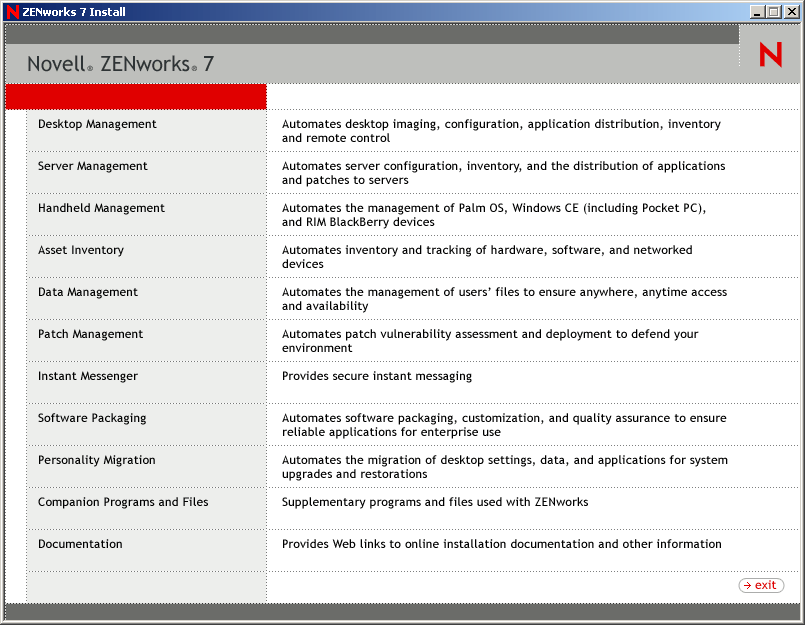
-
Click to display a page with options to install in various languages.
-
Click to display a page with Desktop Management installation options.
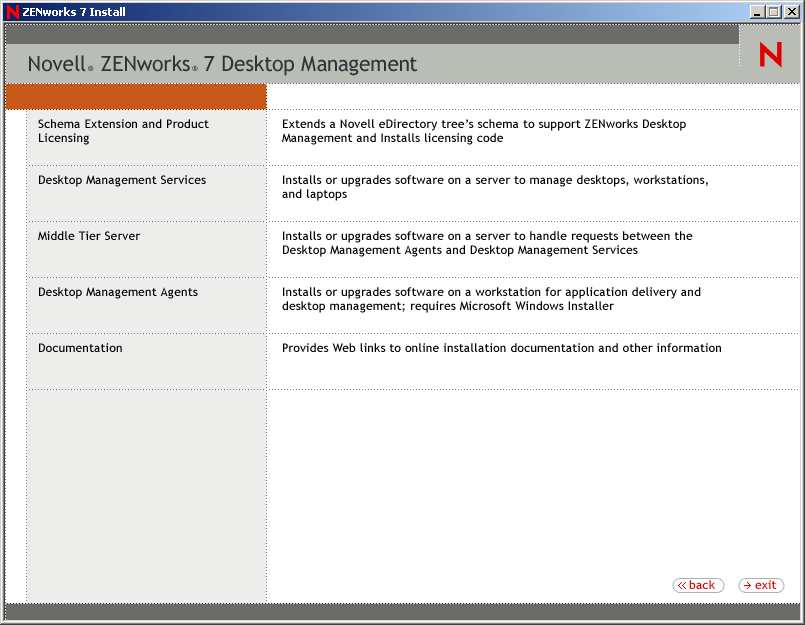
-
Click to launch the Middle Tier Server installation program.
-
On the first Installation page, read the details about running the installation program, then click .
-
Read the License agreement, then click if you agree with the terms of the License Agreement.
If you do not agree with the terms of the license agreement, do not install the software.
-
On the Installation Requirements page, read the requirements for installing the Middle Tier Server software, make sure that the server where you plan to install meets the listed requirements, then click .
-
On the eDirectory Location and Credentials page, select whether your Middle Tier Servers have been previously configured or not, then fill in the fields:
DNS/IP Address: Specify the DNS name or IP address of the server where eDirectory is installed.
Username (full DN): Specify the fully-qualified distinguished username of the Middle Tier proxy user account (for example, midtier-proxy.org-unit.org). To ensure that these credentials remain secure, you can set up an arbitrary user with specific administrative rights.
For a description of the required rights, see Section 10.3, Required Rights for the Middle Tier Proxy User Account and the NSAdmin Utility.
Password: Specify the eDirectory™ password for the Middle Tier proxy user.
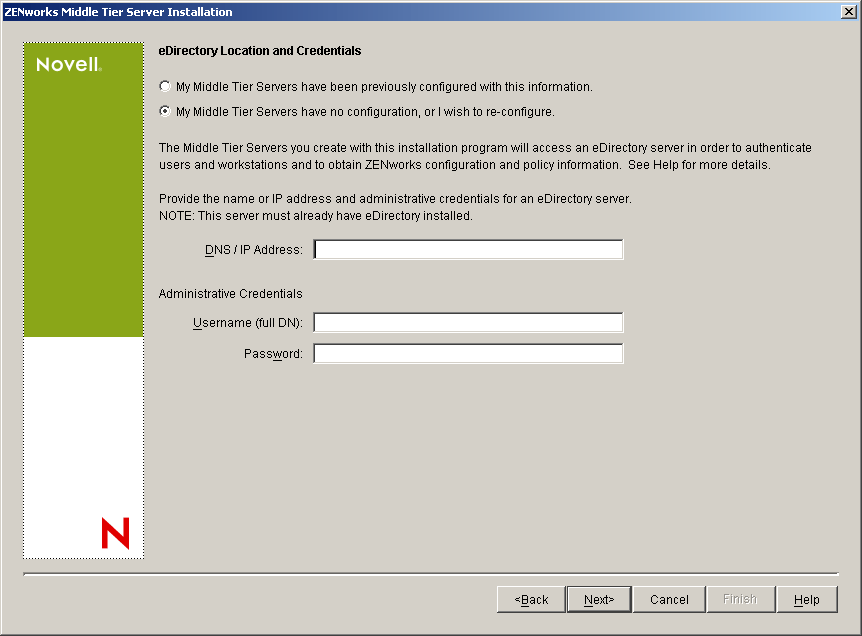
-
(Conditional if you have no previous Middle Tier configuration) On the ZENworks User Context page (User Context field), specify the eDirectory context where the Middle Tier Server can look for user objects that will be used by Desktop Management.
You should use the context of the highest-level container where user objects reside. This value is passed to the ZENworks Middle Tier Server, which uses it as a starting point in searching for a user.
For example, if users exist in many subcontainers, specify the context of the container that holds all of those subcontainers. When a user logs in through the ZENworks Middle Tier Server, the server begins searching for a user in the designated eDirectory container, then searches subcontainers in that container until the correct user is found.
For any Middle Tier Server you designate during this installation, currently configured authentication domains (for example, the authentication domain configured for NetStorage) are replaced by a single authentication domain having the context that you specify here.
After the installation, you can reconfigure this authentication domain context using the NSAdmin utility. You can open the utility in a Web browser (http://middle_tier_server_name/oneNet/nsadmin).
The installation program verifies the existence of the context (that is, the container) before continuing.
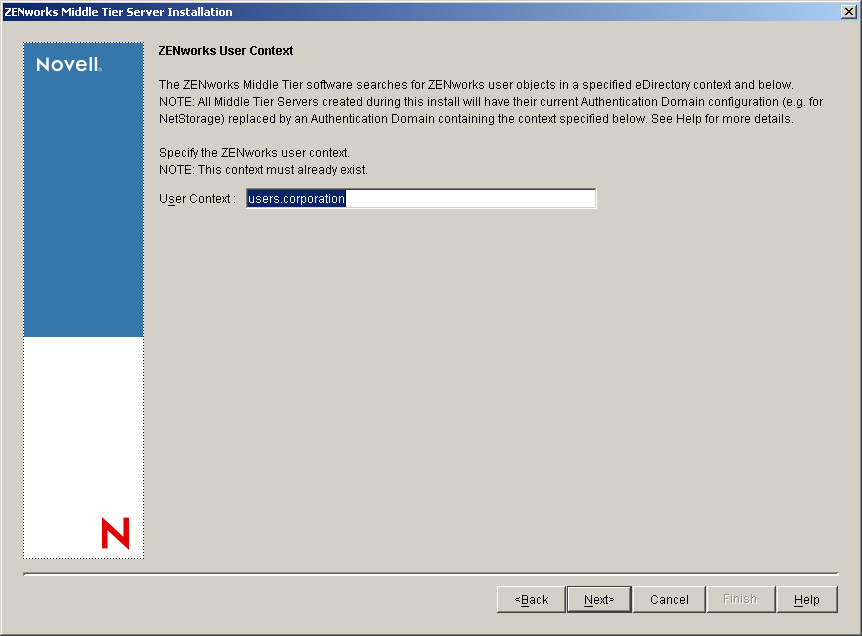
-
(Conditional if you have no previous Middle Tier configuration) On the ZENworks Files Location page, select the network location where you will access application and policy files managed by ZENworks.
The ZENworks Middle Tier Server requires access to ZENworks files installed elsewhere on your network. As the ZENworks Administrator, you define the location of these files when you create policies or applications for distribution. The information you provide on this page is used to help the Middle Tier Server determine how to access different file systems. This decision is necessary for the installation now, even if you have not yet created any ZENworks files.
-
Select the first option button if your ZENworks-managed application and policy files will be located on NetWare servers only.
-
Select the second option button if some or all of your ZENworks-managed application and policy files will be located on Microsoft Windows servers.
If your ZENworks files are located in a Windows file system, the Middle Tier Server might not be able to access them using a username and password for Novell eDirectory; instead, it requires Windows domain credentials to access the files.
If the files are located on a server not belonging to a domain, enter server-specific credentials.
Domain Username: Specify the username of any user in the Microsoft domain who has Windows file system rights to the ZENworks file locations.
Password: Specify the password for the user in the Microsoft domain who has file system rights to ZENworks files.
Confirm Password: Specify the same password to confirm that it was entered correctly.
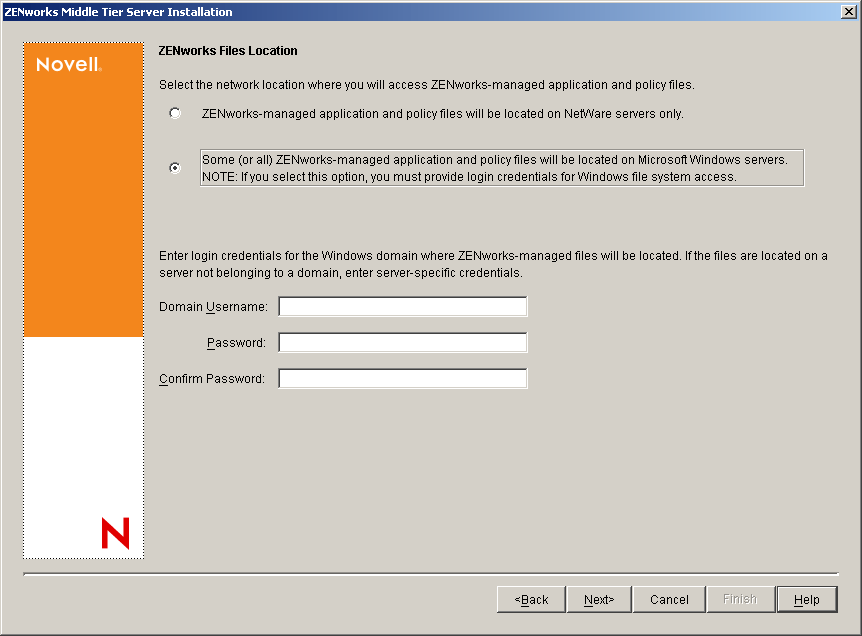
-
-
On the Server Selection page, you need to build a list of target servers that you want to function as Middle Tier Servers. The button calls a dialog box that is used to find and add servers to the list. The Remove Servers button lets you delete servers from the target list after they are added. Click .
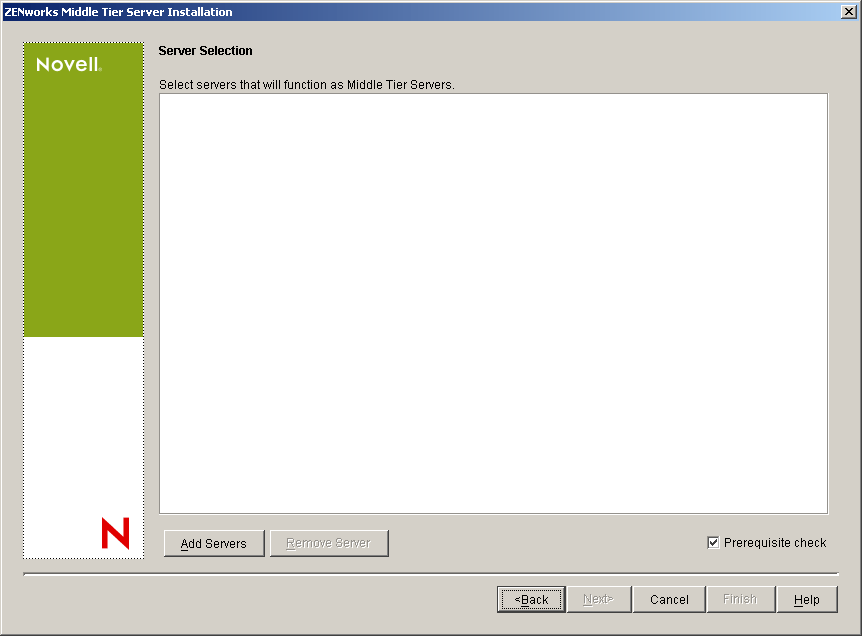
-
(Optional) is selected by default. Retain this selection if you want the installation program to verify that the server or servers meet the installation requirements for ZENworks Middle Tier Servers.
The installation program checks the version of any previously installed Middle Tier Server software, the server's network operating system (including any required service or support packs), the presence and version of the IIS Web server on Windows servers, the presence and version of the appropriate Web server on NetWare servers, and the presence and version of NetStorage (2.6.0) on target servers.
If the server operating system and support/service packs are not the correct version, the installation displays a warning message, but can continue. If other requirements are not met, the installation displays a warning and does not continue until the required software is installed and detected.
-
On the Add Servers dialog box, open the drop-down list to show the options of listing the servers according to their location in Novell eDirectory trees, in Microsoft Windows Network structures, or in Microsoft Active Directory trees.
You can install the ZENworks Middle Tier Server software to several servers during the installation. When you have finished adding servers to the list, click .
Both the Desktop Management Server installation program and the Middle Tier Server installation program allow you to select servers from only one eDirectory tree. If you run either of these installation programs from a Windows server and if that server is not part of the tree you have selected, you cannot install the Desktop Management Server locally.
-
(Conditional if you want to list servers in eDirectory trees.) In the drop-down box, select to list all of the eDirectory Trees to which you are currently authenticated, then browse the tree to the server of your choice, then click the double right-arrow to move it to the list box.
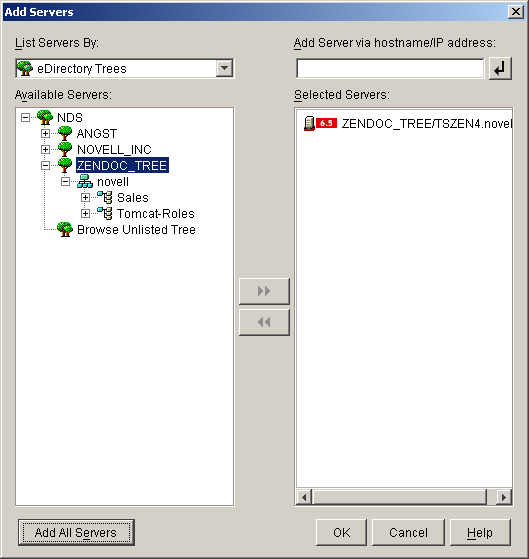
Other options in this dialog box include the following:
-
You can click to open a dialog box listing all of the trees in your network. Double-clicking any one of these trees moves it to the list, even though you are not authenticated to that tree.
-
You can specify the hostname or IP address of a server in the field. The value that you enter must be resolvable to the name of a server.
Click
 to begin the name resolution process and add the server to the list.
to begin the name resolution process and add the server to the list.
-
If you select a server to which you are not authenticated, you are prompted to provide eDirectory credentials for that tree.
-
Click to add all of the servers in a selected tree or container when authentication is complete. Selecting a high-level container selects all of the servers in that container and in all of its subordinate containers.
-
To remove a server from the list and return it to the list box, click the server name in the box, then click the double left-arrow. You can remove multiple servers from the list by selecting them with the Shift and Ctrl keys.
-
-
(Conditional if you want to list servers in Microsoft Windows Network structure.) In the drop-down list, select to list all of the Windows Workgroups and Microsoft Domains to which you are currently authenticated, browse the structure to the server of your choice, then click the double-right arrow to move it to the list.
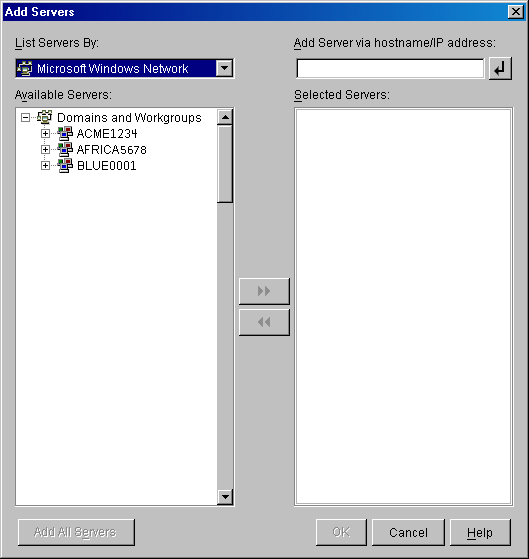
Other options in this dialog box include the following:
-
You must be an administrative user for a server in order to add it to the list. If you are not authenticated to a server, the object is designated by a question mark. You can double-click the question mark to authenticate to the server, then click the double-right arrow to move the server to the list, if it is a supported server platform for ZENworks 7 Desktop Management.
-
When you list servers in Microsoft domains, NetWare servers are not listed for browsing because ZENworks files that are located on a Windows server cannot be obtained through a Middle Tier Server installed on NetWare.
-
You can specify the hostname or IP Address of a server in the field. The value that you enter must be resolvable to the name of a server located in the designated operating environment.
Click
 to begin the name resolution process and add the server to the list.
to begin the name resolution process and add the server to the list.
If you are using multiple hostname aliases for a Windows server, the first alias must be the physical name of your Windows server.
-
If the credentials you provided for authentication to the server (see Step 11) are not administrative credentials, you can add it as a target server, but you are re-prompted for Administrative credentials when you close the Add Servers dialog box.
-
Click to add all of the servers in a selected domain or workgroup. Selecting a domain or workgroup selects all of the authenticated servers in that domain or workgroup.
-
To remove a server from the list and return it to the list, click the server name in the list, then click the double left-arrow. You can remove multiple servers from the list by selecting them with the Shift and Ctrl keys.
-
-
(Conditional, if you want to list servers in a Microsoft Active Directory.) In the drop-down list, select . If your workstation is a member of an Active Directory, the domains in the Active Directory trees are displayed. You can browse to all of the servers listed in Active Directory (on a per domain basis), browse the structure to the server of your choice, then click the double right-arrow to move it to the list.
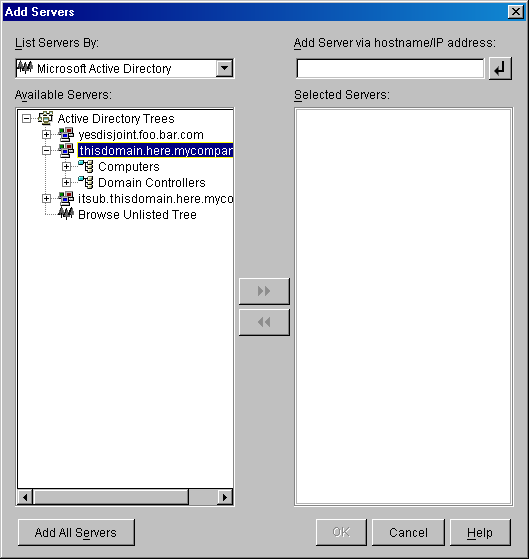
Other options in this dialog box include the following:
-
You can also click to open a dialog box where you can specify the name of the domain you want to add, then authenticate to it with the proper credentials prior to displaying its servers in the drop-down list.
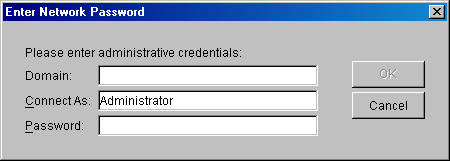
-
You can specify the hostname or IP address of a server in the field. The value that you enter must be resolvable to the name of a server located in the designated operating environment.
Click
 to begin the name resolution process and add the server to the list.
to begin the name resolution process and add the server to the list.
-
Right-click a domain object to select one of three search methods:
Search Standard Locations: Lists the computers and domain controllers at the root of the domain. This is the default search method.
Search Entire Directory: Lists all directory containers where computers are located.
Browse Directory Hierarchy: Lists all of the containers in the directory, which you can expand and browse one at a time to find the computer you want. This search method might be useful if you have computers in a non-standard location of a large directory.
-
Click to add all of the servers in a selected domain or container. Selecting a domain or container selects all of the servers in that domain or container.
-
To remove a server from the box and return it to the list box, click the server name in the box, then click the double left-arrow. You can remove multiple servers from the box by selecting them with the Shift and Ctrl keys.
-
-
-
On the Summary page, review the location where you have chosen to install the ZENworks Middle Tier Server software and the Desktop Management Server to which it is associated, then click to begin the installation process if the summary is correct.
The Middle Tier Server Installation Wizard launches another installation program. Wait until this program is completed.
IMPORTANT:You can review the installation log file after the installation has completed. The log file name is datestamp_timestamp_zdmmidtier_install.log (for example: 20040304_024034_zdmmidtier_install.log). It is located in the \novell\zfdtemp directory on the machine you are installing from. This log file indicates whether any component failed to install.
You can also review the installation summary to review the selections you made. The summary is saved in a log file named datestamp_timestamp_zdmmidtier_installsummary.log (for example: 20040304_024034_zdmmidtier_installsummary.log). It is also located in c:\novell\zfdtemp.
-
In ConsoleOne pointing to eDirectory on the Desktop Management Server, make sure you have set up the Desktop Management Server to allow clear text passwords. See Step 15 for more information.
-
(NetWare 6 Installation only.) Edit the autoexec.ncf file on the NetWare 6 ZENworks Middle Tier Server so that the Apache Web Server can load and bind properly. For more information, see Section 10.4, Editing Autoexec.ncf on a NetWare 6 ZENworks Middle Tier Server.
-
Reboot the server where you installed the ZENworks Middle Tier Server software.
-
Verify that the ZENworks Middle Tier Server is installed and running by entering one of the following URLs at a browser on the workstation:
- http://Middle_Tier_Server_DNS_or_IP/oneNet/xtier-stats
- http://Middle_Tier_Server_IP_address/oneNet/zen
If the ZENworks Middle Tier Server is running, the first URL opens a Web page where server statistics are displayed. You should be able to see where the request count increases by clicking the Refresh button on your browser.
If you are not authenticated, the second URL launches a dialog box that prompts for user credentials. If you are authenticated, the URL launches a Web page where a message is displayed stating that XZEN (the Xtier module in the Middle Tier Server) is running.
IMPORTANT:If you previously installed the ZENworks 7 Middle Tier Server on an OES NetWare server, and then you subsequently upgrade the NetWare server to OES Support Pack 1, the support pack installation program overwrites the ZENworks 7 Middle Tier Server (version 2.0x) with a newer version of XTier (version 3.01). This version of XTier is not compatible with other ZENworks 7 Middle Tier components and effectively disables the Middle Tier.
If you must upgrade your OES server with OES Support Pack 1, you can work around the problem by reinstalling the ZENworks 7 Middle Tier Server after the OES upgrade.